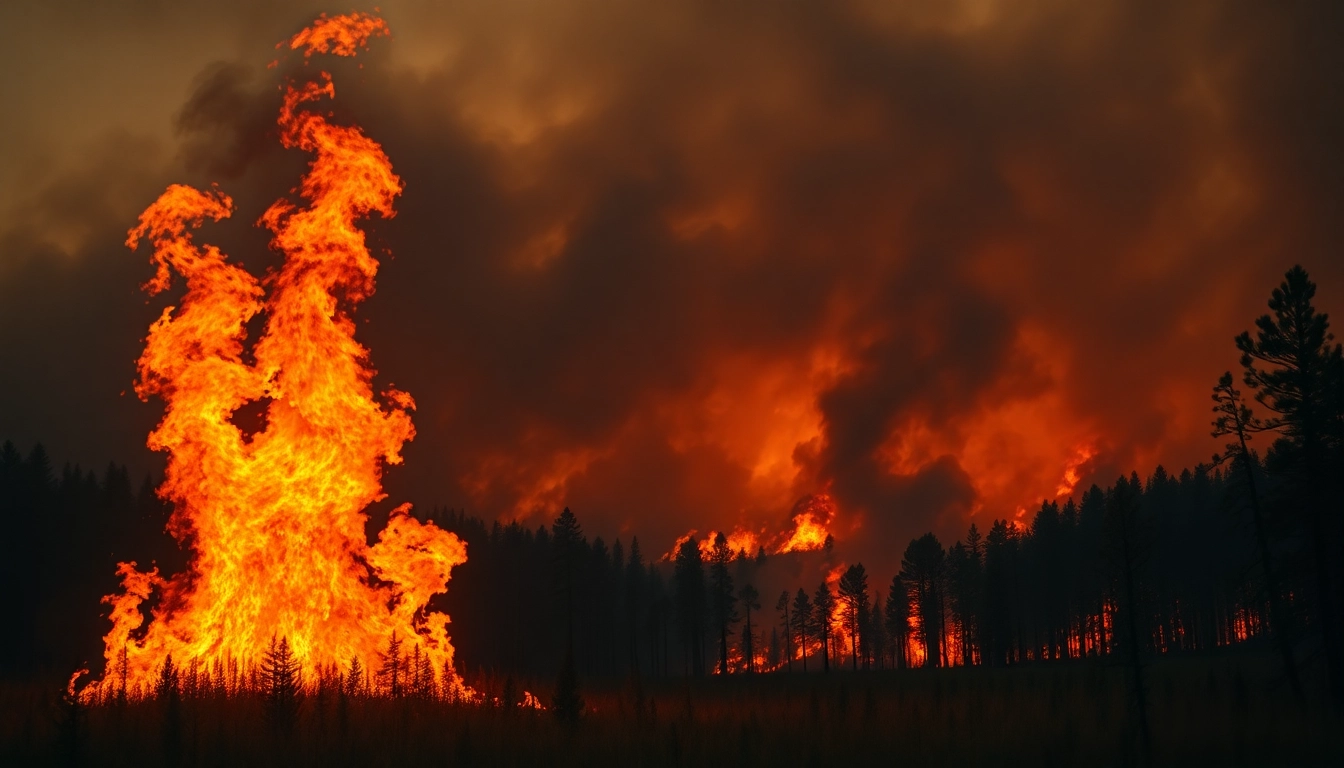Overview of Wildfire Events
Wildfires are natural events that can have devastating effects on landscapes, ecosystems, and communities. As climate change intensifies, the frequency and severity of these fires have increased, prompting a need for in-depth understanding and effective management strategies. This article explores various aspects of wildfire events, including their definitions, historical context, causes, and the importance of preparedness and response. By gaining insights into wildfire events, we can better equip ourselves to handle their implications in the future.
Definition and Types of Wildfire Events
A wildfire, also known as a forest fire, bushfire, or grass fire, is an uncontrolled fire that spreads rapidly, often fueled by vegetation and weather conditions. Understanding the different types of wildfires is crucial for effective management and response:
- Surface Fires: These are the most common type of wildfire, where flames burn along the forest floor, consuming grass, shrubs, and small trees. They are often easier to control.
- Crown Fires: These fires occur in the upper canopy of the forest, devastating entire tree populations. They are often driven by strong winds, making them difficult to control.
- Ground Fires: Burning underground, ground fires are most common in peat or organic soils and can remain smoldering for extended periods, only to flare up again under dry conditions.
Historical Context and Trends in Wildfire Events
The historical context of wildfires is deeply interwoven with climatic variations and human activities. Historical records illustrate patterns of wildfires dating back centuries, with significant shifts observed over time. For example, the 1910 Great Fire in Idaho and Montana burned over three million acres and highlighted the necessity for organized fire management strategies.
From the mid-20th century onward, fire suppression became a principal strategy, significantly affecting forest health and ecosystem dynamics. Recent trends indicate a shift towards recognizing the role of fire in ecosystem health, prompting discussions about controlled burns as a management technique. In recent years, jurisdictions have faced alarming wildfires exacerbated by climate change, drawing attention to the urgent need for integrated wildfire management strategies.
Key Causes and Factors Contributing to Wildfire Events
Several factors contribute to the ignition and spread of wildfires:
- Natural Causes: Lightning strikes account for a significant percentage of wildfires, especially in remote areas. Drought and high temperatures create conditions that facilitate fire ignitions.
- Human Activities: Approximately 85% of wildfires are triggered by human actions, including campfires left unattended, discarded cigarettes, and intentional acts of arson. Urban expansion into wildland areas has also increased the likelihood of wildfires.
- Climate Change: Rising temperatures and prolonged droughts create optimal conditions for wildfires. Regions that previously experienced mild fire activity are now susceptible to larger, more intense wildfires.
Preparing for Wildfire Events
Recognizing Wildfire Risks in Your Area
Understanding the specific risks in your area is the first step in wildfire preparedness. Various factors should be considered:
- Geographic Location: Determine whether you live in a wildfire-prone area, particularly in regions with dry vegetation and seasonal winds.
- Climate Patterns: Monitor local climate trends that suggest increasing wildfire risks, including drought conditions or unusually dry winters.
- Community Infrastructure: Evaluate the proximity of your home to forested areas and evaluate the existing fire breaks or safety zones within your community.
Developing an Emergency Preparedness Plan
An effective emergency preparedness plan should be comprehensive and regularly updated. Key components include:
- Creating an Evacuation Route: Identify several routes from your home to safe locations. Make sure all family members are aware of these routes.
- Establishing a Communication Plan: Designate how you will communicate with each other during a wildfire event. This can include designated meeting points or communication apps.
- Preparing an Emergency Kit: Assemble a kit that includes essential supplies such as food, water, medications, and important documents.
Community Initiatives and Involvement in Wildfire Preparedness
Communities play a vital role in wildfire preparedness. Collective action can enhance safety and resilience:
- Organizing Community Firebreak Initiatives: Collaborate with local fire departments to create and maintain firebreaks that can prevent the spread of wildfires.
- Hosting Educational Workshops: Communities should host workshops and training sessions for residents to educate them on specific wildfire risks and preparedness steps.
- Establishing Local Fire Watch Programs: Encourage residents to participate in fire watch programs where individuals can monitor local conditions and report potential fire hazards.
Responding to Wildfire Events
Immediate Actions During a Wildfire Event
When a wildfire occurs, immediate actions can save lives and property. Understanding these actions can make a critical difference:
- Evacuation: If advised to evacuate, do so immediately. Listen to local authorities for evacuation orders and follow marked routes.
- Staying Informed: Utilize local media, social media, or emergency alert systems to stay updated on the fire’s progression and any new developments.
- Preventing Fire Spread: If safe to do so, create a defensible space around your home by clearing debris and flammable materials.
Resources and Organizations for Fire Response
Several organizations offer resources and support during wildfire events:
- National Interagency Fire Center (NIFC): Provides national analysis of fire activity and response coordination.
- State Forestry Agencies: Most states have their bodies dedicated to forestry management and can assist with local wildfire incidents.
- Local Fire Departments: Always your first point of contact in emergencies, local fire departments lead firefighting efforts and have community-oriented fire prevention programs.
Importance of Cooperation among Emergency Services
Effective response during wildfire events hinges on cooperation among various emergency services:
- Cross-Agency Collaboration: Firefighters, law enforcement, and emergency medical services must work collaboratively to effectively manage evacuations and healthcare for displaced individuals.
- Mutual Aid Agreements: Establishing agreements between neighboring jurisdictions can enhance resource sharing, enabling a quicker, more robust response.
- Public Education Campaigns: Joint campaigns between agencies can foster community preparedness, ensuring residents understand the importance of immediate action during wildfires.
Long-Term Management of Wildfire Events
Strategies for Wildfire Mitigation
Effective long-term wildfire management requires comprehensive strategies, including:
- Creating Fire-Resilient Landscapes: This involves managing vegetation, such as removing dense undergrowth and promoting healthy forest ecosystems.
- Implementing Controlled Burns: Controlled or prescribed burns can reduce fuel load and improve fire resilience within the ecosystem.
- Urban Planning Initiatives: Developing standards for building materials and landscaping can greatly reduce wildfire risk in urban interface areas.
Role of Technology in Wildfire Management
Technology plays a crucial role in modern wildfire management:
- Remote Sensing: Satellite imagery and drones facilitate monitoring of fire conditions and forecasting fire spread.
- GIS and Mapping Tools: Geographic information systems (GIS) can analyze terrain and vegetation, providing critical data for response planning.
- Predictive Modeling Tools: Utilizing sophisticated algorithms, predictive models can assess fire risks and guide firefighting strategies effectively.
Post-Fire Recovery and Restoration Efforts
After a wildfire, recovery and rehabilitation are critical for both ecosystems and communities:
- Ecosystem Recovery: Interventions such as reseeding and erosion control are essential to restore affected areas.
- Community Support Programs: Establishing resources for affected homeowners, including financial aid and mental health services, is vital for community recovery.
- Reviewing Response and Recovery Plans: Post-event assessments help refine existing plans, ensuring better preparedness for future events.
Future Trends in Wildfire Events
Impact of Climate Change on Wildfire Frequency
Climate change is expected to increase wildfire frequency and intensity due to higher temperatures and prolonged dry spells. These changes will require a re-evaluation of existing management strategies to accommodate new realities:
- Increased Research Funding: Investing in understanding climate impacts on fires can better inform prevention and response strategies.
- Promoting Community Resilience: Communities must enhance resilience through education and tangible preparedness initiatives, particularly in high-risk zones.
Innovations in Wildfire Control and Prevention
The future holds potential for innovative techniques in wildfire control and prevention:
- Fire-Resistant Building Materials: Advancements in construction materials can lead to enhanced fire resistance in homes and infrastructure.
- Automated Monitoring Systems: The development of smart sensors capable of detecting fire conditions in real-time can significantly improve response times.
Education and Advocacy for Sustainable Practices
Sustained efforts in education and advocacy are essential for effective wildfire management:
- Public Awareness Programs: Engaging communities in educational campaigns on responsible land management helps mitigate wildfire risk.
- Advocating for Policy Changes: Policy reforms promoting sustainable practices in land use and forestry can reduce long-term wildfire risks.









